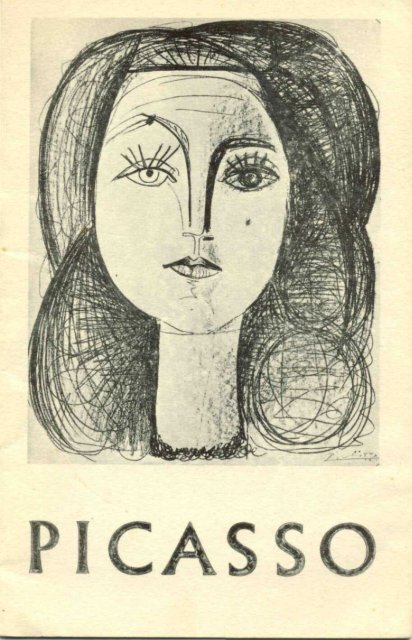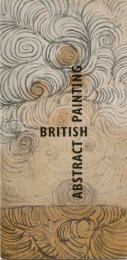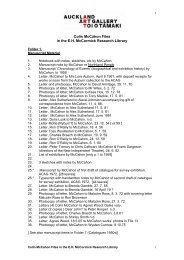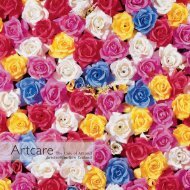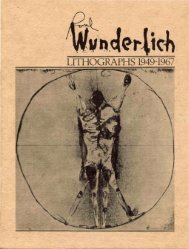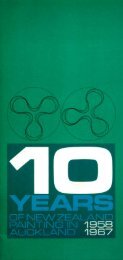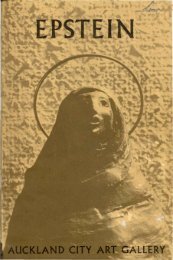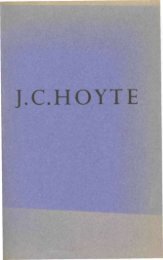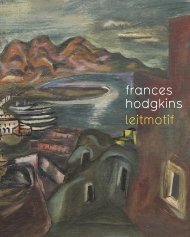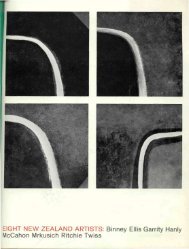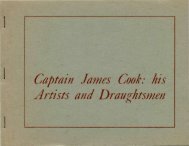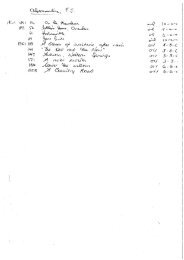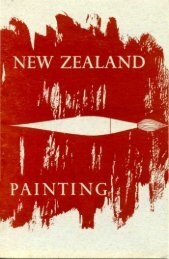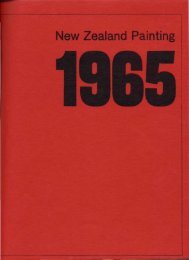picasso - Auckland Art Gallery
picasso - Auckland Art Gallery
picasso - Auckland Art Gallery
You also want an ePaper? Increase the reach of your titles
YUMPU automatically turns print PDFs into web optimized ePapers that Google loves.
p IASSO
ADDENDANo 16 65x50 10/50No 17 65x50 18/50No 18 7th MarchNo 20 23rd MarchNo 23 llth MayNo 27 10th NovemberNo 33 26th MarchNo 35 8th MarchNo 40 10th MarchNo 41 llth MarchNo 43 18th AprilNo 46 26th NovemberNo 48 15th FebruaryNo 56 23rd JanuaryNo 58 18th January-No 59 20th JanuaryNo 70 18th MayNo 73 13th NovemberNo 74 24th AprilNo 77 3rd JuneERRATAInsert ' 1954' above item No 60FRONT COVER(9) FEMME AUX CHEVEUX LISSES (Woman with glossy
PICASSOAn exhibition ofLITHOGRAPHS fie AQUATINTS1945-57Printed by THE PELORUS PRESS LTD, <strong>Auckland</strong>, New Zealand
FOREWORDSOME TIME AGO we wrote to M. Daniel-HenriKahnvveikr asking him if he would be agreeable toarranging an exhibition of graphic work by Picasso.He has been more than agreeable, he has beenmost generous. Not only has he put together anexcellent collection, but also has spared time towrite for us a long introduction. We are extremelygrateful to him.p. A. TOMORYAugust, 1958The exhibition will lie seen inAUCKLAND, DLTNEDIN, WELLINGTON, NEWand in MELBOURNE, AUSTRALIAZEALAND
when Kandinsky had painted his first abstract works. It was out of lyrical abstractionthat tachism was born a few years ago. Tachism has now invaded exhibitions ofpainting throughout the world.Abstract art has assimilated certain ideas of Surrealism asking for the freedom ofthe instinct respecting the accidental. ' Automatic writing' which Surrealism had practisedis applied here in painting. No one will deny that this may provide a pleasantgame for the author and even for the spectator, but never will I believe that this canbe considered as painting, cosa mentale, as Leonardo da Vinci said.This long preamble is intended simply to prevent a misunderstanding. I would notwish the works of Picasso which are being shown in New Zealand and Australia to beregarded as abstractions. They are not exercises in style either. If Picasso is the greatestpainter of our time —this is what I think and I am not alone in thinking it —it isbecause he has invented the most striking new symbols in order to make us share hisemotion at the spectacle of life. To paint is to invent symbols.Our epoch, after centuries during which painters were only painters, knows oncemore numerous artists who are painters, sculptors and engravers all at once, like theartists of the Renaissance.Picasso is such a complete artist. He not only makes paintings, sculptures, prints,ceramics, mosaics, but there have been occasions during his life when he has had needof words in order to externalise himself. He has written admirable poems in Spanishand French. In all this there is no frolic; according to circumstances he has felt theneed of expressing himself by one or other of these means. Thus the lithographs whichmake up the majority of the prints exhibited here owe their existence to a banal factof daily life. The winter of 1945-6 was very cold in Paris and stocks of coal had stillnot been replenished. Private homes were not heated and Picasso's studio was glacial.The Mourlot lithographic printing works, as an industrial building, had a coal allocation.Picasso went there to work one day and found himself at ease in this heatedenvironment and he returned there to work every day for several months. It is thusthat his first lithographs, printed by Mourlot, came to be born, and they constitute hisreal debut in this technique. He had indeed made some before, but they were, rather,only drawings executed on stone. On the contrary, during this winter, as always whenhe touches something, he became excited over the technical possibilities, he refashionedthe medium of lithography. To be precise, it was not a question of virtuosityin the medium but of new possibilities (did he not say, one day, ' I do not search,I find'), new means to externalise himself in order to 'Donner a voir' (To give toseeing), if I may be allowed to use the beautiful title of a book by Paul Eluard, whowas a close friend of Picasso. Let me explain. What is extraordinary is Picasso'smemory of plastic forms, of innumerable visual experiences which store themselves inhis mind.One of our friends, Andre Beaudin, a younger painter of great talent, told me thathe saw Picasso working one day in the studio of Lacouriere, the printers. Picasso wasin the process of engraving one of his illustrations — The Frogs —for Buffon's NaturalHistory. ' One would have said,' Beaudin told me, ' that he had the animal in front ofhim. Each muscle was there!' In this way he makes us share in his treasure ofimages, and by them, the world around us is prodigiously enriched.Engraving is not a subsidiary activity in Picasso's life. It plays as important a roleas his painting and sculpture and it began as early as they did. It was in 1899 that hemade his first etching — a picador. He called it El Zurdo (The left-handed man), fornot knowing the medium too well he took no account of the fact that the engraved
design on the plate was reversed on the paper: the picador holds his spear in his lefthand. Engraving, at times, has even taken the place of drawing so that he has expressedhimself only on to plate or stone. The life and art of Picasso are one. Everythingwhich troubles his existence reflects itself in his art — his joys, his anxieties, hisloves, his hates. Today he is encamped at Cannes in a huge, dilapidated house, encumberedwith a thousand objects, yet sparsely furnished. It looks over a'fine sloping park.He hardly ever leaves house or park. He does not go anywhere except to the bullfightsat Aries or Nimes. He lives only for his work and anything which might disturbit is thrust aside.Hokusai, towards the end of his life, signed his work 'The old man mad withdrawing.' I would give the same name to Pablo Picasso — but he is so young, unbelievablyyoung.Sf Hilaire, France7th July, 1958DANIEL-HENRY KAHNWEILERBiographical noteM. Daniel-Henri Kahnweiler opened his first gallery in 1907 in the Rue Vignon,Paris. From 1908 to 1914 he handled exclusively the work of Picasso, Braque, Gris,Leger, Derain and Vlaminck. He now directs the Galerie Louise Leiris with his sisterin-lawand Maurice Jardot. It may be said of him, as of Durand-Ruel, Tanguy andVollard, that he belongs to the hierarchy of the dealer-patron of twentieth century art.
(78) BACCHANALE PICASSO-[8]-
THE CATALOGUEThe following publications have been consulted in the preparation of this catalogue, and tlieabbreviations in the text refer to where the work has been reproduced:B/S - BOECK/SABARTES, Picasso, Thames & Hudson. A.C. - The <strong>Art</strong>s Council of GreatBritain, Picasso: fifty Years of Graphic <strong>Art</strong>, June-August, 1956. B — BOLLINGER, Picasso:55 Years of His Graphic <strong>Art</strong>, Thames & Hudson.All measurements given are in centimetres, height preceding width, and refer to the whole sheet.19241 MATERNITE (Maternity)Aquatint 6k dry point57x76<strong>Art</strong>ist's proofAlthough executed in 1924, it was not publisheduntil 1955.19452 TETE DE GARCON(Head of a Boy)Lithograph 7th November44x33 24/50B pi.1193 TETE DE FEMME SURFOND BLANC(Head of a Woman on a white ground)Lithograph 2nd November44x33 43/50The technique used here is to cut out the inksubject, paste to transfer paper, which is thentransferred to the stone.4 COMPOTIER ET TASSE(Fruitbowl and cup)Lithograph 16th November33 x 44 47/50B pi. 11819465 LE TALIREAU (The Bull)Lithograph 17th January33x44 24/50Picasso produced no less than 11 states ofthis work. Commencing with a naturalistic-[9]-wash-drawing on the 5th December, 1945,Picasso by turns conceives it in his expressionistand then cubist manner, finally arrivingat a linear symbol. Each state is completein itself.B/S p. 100-1036 COOUILLAGES ET OISEAUX(Shell-fish and birds)Lithograph 19th February33x44 12/507 DEUX FEMMES MIES(Two nudes)Lithograph 12th February33x44 3/50There were 18 states of this work commencinglike No. 5 from a wash-drawingB/S p.2508 FRANCOISE AU NOEUDDANS LE CHEVEUX(Francoise with a bow in her hair)Lithograph 14th June65 x 50 7/50Eleven plates were devoted to Francoise.Francoise Gilot joined Picasso in 1946 andthey now have two children. After the warPicasso escaped to the South and in its moresympathetic climate, with Francoise Gilot athis side, he entered on a sustained period ofcreative activity.9 FEMME AUX CHEVEUXLISSES (Cover)(Woman with glossy hair)Lithograph65x50 47/50
194710 LA CENTAURESSE(The Centauress)Lithograph 26th January50x65 18/50During the battle of Paris, 1944, Picassomade a version of Poussin's Bacchanal in theLouvre. This was followed later by a painting,La joie de vivre. Picasso uses mythologicalpaganism as a symbol for the Mediterraneanand provides for our own age acontinuance of that rich, sensual traditionwhich the Mediterranean has maintainedalmost since the beginning of time.11 LE HIBOU SLIR LA CHAISE(Owl on a chair)Lithograph 20th January65x50 39/50Michel Sima gave Picasso a small owl atAntibes in 1946. Picasso made a first drawingof it in November, 1946, and followedthis up with more drawings in 1947, arrivingat the point of this lithograph. However, hewent on by drawings and paintings to finallyceramics, in 1950. Thus the artist finds inthe owl significant linear, formal and symbolicalqualities.B pi. 130. B/S cat. 202.12 DAVID ET BATHSABEE(David and Bathsheba)Lithograph 30th March65 x 50 5/50(various states) AC pl.42. B pis. 146, 147.Like the Poussin Bacchanal mentioned inNo. 10, this is another of Picasso's borrowings.It is his version of Lucas Cranach's(1472-1533) painting of the same title. Thistheme went through seven states in all, eachone being a distinct variation both in termsof alterations and complete changes in technique.Here again one recognises Picasso'sability to transform the images of anothercentury so that they become wholly meaningfulfor our own.13 DAVID ET BATHSABEELithograph65x50 8/50\14 DAVID ET BATHSABEELithograph65x50 11/5015 LE PIGEON ET SES PETITS(The Pigeon and her Young)Lithograph 19th March50x65 17/50The pigeon with the olive branch and wearinga tricolor hat is a forerunner of the LaColombe, No. 32.16 CENTAURE, FAUNE ETNYMPHE(Centaur, faun and nymph)Lithograph 2nd FebruaryB pi. 12617 DORMEUR ET FEMMEASSISE(Sleeper and seated woman)Lithograph 11th MayThis is a familiar subject and is treated mostfully in the Vollard Suite dating from 1933.AC pl.3618 FLEURS ET FRUITS(Flowers and fruit)Lithograph50x65 15/5019 LE TALIREAU NOIR(The Black Bull)Lithograph 20th April50x65 6/50In this work Picasso produces an amalgamof the earlier series (see No. 5). Here onesees the colossal whole of the parts in thevariations. A symbol both for the sympatheticmagic of early man and the brute power ofthe twentieth century.B/S p.106-[10]-
120 DORMEUR ET FEMiMEACCROUPIE(Sleeper and crouching woman)Lithograph50x65 18/5021 BOUQUET ET COMPOTIER(Bouquet and fruit bowl)50x65 16/5022 LA TETE ECLAIREE(Illuminated Head)Lithograph65x50 6/5023 DEUX FEMMES SUR LAPLAGE(Two women on the beach)Lithograph50x65 18/50Here Picasso returns to a subject which heintroduced first in the 1920's. (See a linedrawing, B/S p.21.)194824 LE GRAND HIBOU(The large owl)Lithograph 10th March76x56 46/50Here the artist completes the lithographcycle commenced in 1947. Mourlot, theprinter, had brought down to the Golfe Juansome zinc plates so that Picasso couldre-design some illustrations for Reverdy'sChants des Marts. There were seven platesleft over, so the artist did the Owl and sixfaun subjects, two of them being Nos. 25and 26.B pl.131. B/S p.311.25 LE FAUNE BARBU(The bearded faun)Lithograph 10th March76 x 56 9/50(See note to No. 24)26 LE FAUNE DE PROFIL(Faun in profile)Lithograph 10th March76x56 41/5027 L'ATELIER (The Studio)Lithograph65x50 39/5028 GRANDE TETE DE FEMME(The large woman's head)Lithograph65 x 50 49/5029 LE TAUREAU BLANC(The White Bull)Lithograph65 x 50 43/50B pi. 13730 ETUDE DE PROFILS(Study of profiles)Lithograph 8th December76x56 24/5031 FIGURE (Figure)Lithograph 20th November65x50 34/50194932 LA COLOMBE (The Dove)Lithograph 9th January56x76 2/50Picasso made this lithograph for the WorldCongress of Peace poster (Paris, April 1949).Later that year the artist received the PennellMemorial Medal for the design.B pi. 152. B/S cat. 209.33 LA COURONNE DE FLEURS(Crown of flowers)Lithograph65x50 47/5034 LE HOMARD (The Lobster)Lithograph 9th January56x76 17/5035 TETE DE FEMME(Head of a Woman)Lithograph 16th March65 x 50 20/50-[11]-
36 LE MANTEAU POLONAIS(The Polish Cloak)Lithograph76x57 39/56Picasso had visited Poland in 194837 VENUS ET L'AMOUR SURFOND NOIR(Venus and Cupid on a black ground)Lithograph 30th May76x57 5/50B/S cat. 21038 VENUS ET L'AMOUR(Venus and Cupid)Lithograph 25th May79x58 19/50Both this and the one above are based on thepainting by Lucas Cranach (1472-1553)B pi. 14839 DAVID ET BATHSABEE(David and Bathsheba)Lithograph76 x 56 47/50See note to No. 1240 LA GRANDE CORRIDA(The Great Bull Fight)Lithograph56x76 45/50Picasso made two plates, one on the llthMarch and the other on the 21st March. AsM. Kahnweiler mentions in his introduction,Picasso makes regular visits to the bullfights,but also in his youth he had done drawingsof bullfights on the day of the event so thathe could earn his admission money.41 LE PICADOR (The Picador)Lithograph56x76 42/5042 FIGURE AU CORSAGE RAYE(Figure with striped blouse)Lithograph 3rd April65x50 6/50Originally only five proofs were taken of thiswork.Man J50 Years of <strong>Art</strong>ists' Lithographs, pi.10943 LA FEMME A LA RESILLE(Woman in a hair net)Lithograph65 x 50 48/50195044 JEUNESSE (Youth)Lithograph 9th June56x76 2/50This design was used for the poster for theinternational meeting for the prohibition ofatomic arms, held at Nice, 13th-20th August,1950.B pi. 14445 FRANCOISE SUR FOND GRIS(Francoise on a grey ground)Lithograph75.5x57 32/50See No. 8AC pl.4346 LE PIQUE (The Lance)Lithograph50 x 65 47/50195147 JELIX DE PAGES(Pages at play)Lithograph 19th February38x52 12/50Kahnweiler (Le Point, XIII, p.27) recordsthat Francoise Gilot said that Picasso had nogreat knowledge of armour or costume, butalways achieved an astonishing accuracy.Kahnweiler also thought that some illustrationsto Ivanhoe, which had appeared inZ'Humanite had given the artist the idea forthis subject.AC pl.46b. B pl.158. B/S cat. 219.48 LE DEPART (The Departure)Lithograph54x65 25/50-[12]-
195249 LA FEMME A LA FENETRE(Woman at the Window)Aquatint90 x 65 <strong>Art</strong>ist's proofB pi. 154. B/S cat. 274.50 LE PICADOR BLESSE(The Wounded Picador)Aquatint 20th June57x78 46/50This is a companion to another aquatint,Le Picador (18th June).51 PALOMA ET SA POUPEE(Paloma and her doll)Lithograph 14th December76 x 56 44/50Paloma is the artist's daughter, who was bornin 1949. He has painted a number of picturesof her and her brother Claude.AC pl.44. B pi. 160.52 BALZAC 1Lithograph 25th November76x56 13/50B pl.16153 BALZAC 2Lithograph 25th November76x56 17/50B/S p.67In these Balzac portraits Picasso recalls hisearlier illustrations (1924) for Balzac'sUnknown Master-piece, published in 1931 byVollard. In Balzac 1, Picasso re-employs theline ending in a blob of ink which characterisesthe drawings of 1924 (see B/S, p.31).Balzac 2 is in the same manner of his earlyline portraits like that of Stravinsky.54 LE CRANE DE CHEVRESUR LA TABLE(Goat's head on a table)Aquatint57x75.5 <strong>Art</strong>ist's proofThe goat, like the bull, the horse, the owl,have provided Picasso with endless discoveries.The goat's skull seems to appearfirst in a drawing of 1951.195355 TETE SUR FOND NOIR(Head on a black ground)Lithograph 9th May76x57 8/5056 LA MERE ET LES ENFANTS(Mother and children)Lithograph57x76 16/5057 JARDINS A VALLAURIS(Gardens at Vallauris)Lithograph 15th January57 x 76 4/50Picasso settled at Vallauris in the villaLa Gnlloise in 1498. Paintings of 1950, 1951and 1952 (B/S cat. 215, 217, 218, 221, 222)provide the basis for this work.B/S p.6858 LITALIENNE D'ORSEL(The Italian Woman of Orsel)Lithograph65 x 50 3/5059 LES JEUX ET LA LECTURE(Games and a woman reading)Lithograph57x76 16/5060 DANSES (Dancers)Lithograph 13th February50x65 49/50Picasso returns to a subject which has interestedhim since his earliest period.AC pl.47b. B/S cat. 231.61 LE JEU DE TAUREAU(Bull Game)Lithograph 14th February50x65 49/50B pl.16562 LA DANSE DES BANDERILLES(Dance of the Banderillas)Lithograph 14th February50x65 <strong>Art</strong>ist's proofThe last two works, which stem from the-[13]-
previous one (No. 60), done on the claybefore, explore the dance further. In BullGame the same group of dancers as inDancers form a tableau, and Picasso recallsa youthful memory of such a game playedby young people in Spain with a bull mask.Boeck also makes the point that woman isnow the dominant partner, whereas in theearlier works she is subdued.AC pl.47a. B pi. 164. B/S p.339.63 LA REPITITION(The Rehearsal)Lithograph 21st February50x65 50/50Here Picasso unites reality and mythology.The presence of masks in works of thisperiod, particularly in the great group ofdrawings of November 1953-February 1954,symbolises Picasso's attitude to life as he agesphysically. Masks of clowns, old men, classicalheads make the contrast between theephemeral of reality and the eternity ofillusion and mythology.B/S p.33664 LA FAiMILLE DUSALTIMBANQUE(The Family of Mountebanks)Lithograph 16th February50x65 50/50Picasso returns to subjects of 1905. TheHarlequin's Family, 1905, and The Mountebank,1905. The young woman on the rightin the latter is replaced here by an oldwoman. The young harlequin holding hischild in the former is replaced by an olderman carrying a monkey. In the 1905Mountebanks, the young man and the girlare hand in hand, here they are separatedand opposed, and between them four generationsare grouped together. Woman is againthe active partner. The old woman with hertambourine, the young nude girl and themature woman nursing the baby, emphasisethe passivity of man. The early works havean air of withdrawn melancholy, in this workthere is an immediate optimism.AC pl.46a65 LES TROIS FEiMMES ETLE TORERO(Three women and a toreador)Lithograph 17th February50x65 25/50Picasso, a few days later, returns to the BullGame, but here introduces elements to makeit a Life Game.66 LES DEUX MODELES(Two models)Lithograph 18th March50x65 25/50B pi. 16667 LA POSE NUE(Nude posing)Lithograph 15th March65 x 50 <strong>Art</strong>ist's proof68 LA POSE HABILLE(Clothed model posing)Lithograph 19th March65x50 25/50Both of these lithographs (Nos. 67 and 68)are associated with the group of drawingsreferred to previously (No. 63). Most ofthe drawings in this group were concernedwith the artist and his model. However, theartist is depicted as a peering old man unableto recognise any more the beauty of themodel of whom Rebecca West wrote in aforeword (Verve, VIII, No. 29-30), 'Thetruth is that she symbolises Nature: theliving and visible and tangible world whichwe shall hate to leave behind us when wedie.' Picasso spoke of his fear of old age toM. Kahmveiler, 'Right now we can still doeverything we want. But to want and nolonger be able to, this is what is terrible! . . .'B pi. 16769 LE MODELE ET DEUXPERSONNAGES(Model and two figures)Lithograph 14th March57x77 25/50In this work the presence of the same oldwoman (Nos. 64 and 65) emphasises theold artist's indifference to the attractions ofthe model.B/S p.507-[14]-
195570 LE PETIT DESSINATEUR(The little draughtsman)Lithograph65 x 50 <strong>Art</strong>ist's proof71 LE PEINTRE SUR LA PLAGE(<strong>Art</strong>ist on the beach)Aquatint 5th February63.5x91 49/5072 BUSTE DE FEMME(Bust of a woman)Aquatint 19th March76x57.5 47/5073 L'ATELIER DE CANNES(Studio at Cannes)Lithograph65 x 50 2/50From October 1955 to June 1956, Picassowas engaged on a long series of paintings,including 1'Atelier (The Studio) and Femmedans 1'Atelier (Woman in the Studio), andthis work stems from that series./95674 LE TORERO BLESSE(The Wounded Matador)Lithograph50x65 45/5075 DEUX FEMMES ACCROUPIS(TwoLithographseated women)10th January50 x 65 <strong>Art</strong>ist's proofOn the 26th November, 1955, and on the3rd January, 1956, Picasso painted two pictures,Femme accrou-pie au costume Hire(Woman in a Turkish costume seated), andNu accroupie (Female nude seated). Thislithograph would appear to stem from thesetw'o paintings.76 PROFIL EN TROIS COULEURS(Profile in three colours)Lithograph 28th November65x50 <strong>Art</strong>ist's proofIn the 1930's the artist had done a similarhead, in a veil, with the same zig-zag designon the veil.77 PORTRAIT DE H.K.(Portrait of H.K.)Lithograph65 x 50 <strong>Art</strong>ist's proofA portrait of Henri Kahnweiler.78 BACCHANALE (Bacchanale)(See page 8)Lithograph 27th February57 x 76.5 <strong>Art</strong>ist's proofIn this, Picasso returns once more to Poussin'sBacchanal (see No. 10). The man with thetrumpet, the amphora, mask and lyre arepresent in the Poussin. However the figuresetting free a dove seems to give this worka renewed feeling of optimism.-[15]-
BIOGRAPHICAL NOTE1945 Summer in Golfe JuanAutumn takes up lithograph with Mourlet1946 Francoise Gilot joins himSummer in Golfe JuanAutumn in Antibes1947 Birth of his son ClaudeSummer in Golfe Juan and VallaurisWorks on ceramics with the Ramie's in Vallauris1948 Settles at the Villa La Galloise, VallaurisTo Poland1949 To Italy (Rome and Florence)Birth of Paloma, his daughter1950 Exhibition at Venice BiennaleHonorary citizen of Vallauris1951 Short stay in Paris1952 In Vallauris1953 First great retrospective exhibition in Rome, MilanLyons and Sao Paulo, Brazil1954 Summer in French Pyrenees1955 Winter in ParisMoves to villa in Cannes1956 Cannes1957 Cannes-[16]-


